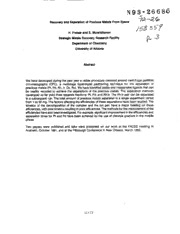
NASA Technical Reports Server (NTRS) 19930017497: Recovery and separation of precious metals from space PDF
Preview NASA Technical Reports Server (NTRS) 19930017497: Recovery and separation of precious metals from space
N93-26686 H. Freiser and S. Muralidhsran Strategic Metals Recovery Research Facility Department of Chemistry University of Arizona Abstract We have developed during the pastyear aviable procedure centered around centrifugal partition chromatography (CPC), a multistage liquid-liquid partitioning technique for the separation of precious metals (Pt, Pd, Rh, Ir,Os, Ru).We have identified stable and inexpensive ligands that can be readily recycled to achieve the separations of the prectous metals. The separation methods developed so far yield three separate fractions: Pt,Pd, and Rh-lr. The Rh-lr pair can be separated ina subsequent run. The total amount of precious metals separated in a single experiment varied from 1to 50rag. The factors affecting the efficlencles of these separations have been studied. The kinetics of the decomposition of the complex and the ion pair have a major bearing on these efficiencles, with slow kinetics resulting Inpoor efficlencles. The methods for the improvement ofthe efficiencles havealso beeninvestigated.For example, significant improvement inthe efficiencies and separation times for Pt and Pd have been achieved by the use of chloride gradient in the mobile phase. Two papers were published and talks were presented on our work at the FACSS meeting in Anaheim, October 1991, and at the Pittsburgh Conference inNew Orleans, March 1992. 11-13 ! ! i ! OvQrallResearch Ob!ectives Our major overall objective ir_this project is to develop efficient and economical large-scale separation and recovery methodsfor the metalsof the platinum group and other precious metals that are suitablefor use inspace. Ouranalysisofthe problem has led usto the use of multistage separation processesInvolvingtwoliquidphasesasthe optimum directionto pursue.The relatively novel separation technique known as Centrifugal Partition Chromatography (CPC), has been selected asthe most promising ofthevarioustypes ofchromatography, particularly from the point of view of scale up, as well as the strong scientificsupport provided by analogies to solvent extraction, an area of greatstrength inour group. Proares_ tO DatQ Centrifugal Partition Chromatography (CPC), a recently introduced countercurrent liquid-liquid distributiontechnique, usedmainlyfor the separation ofabroad spectrum of organic compounds, hasnowbeenapplied totheseparationsofmetalions.We werethefirst todemonstrate theefficient separation by CPC of adjacent lanthanides, including the separation of both light and heavy lanthanides Ina singlerunusinggradient pH elution. With NASAsupport, wewerethe first to achievethe separation ofpalladium(ll) from the other PGM with CPC usinga mixed complex, Pd(TOPO)2CI2.These studies revealed that, under comparable conditions, CPC efficienciesfor metal ionsseparations were significantlylower, by a factor of 4-5, than those regularly seen for organic compounds. Another anomaly that occurs with metal ion separations isthat unlikethe behavior of organic compounds, column efficiency depends on the distributionratioofagivenmetalspecies.Althoughnotcommented on intheliterature,similarlylow efficienciesandtheirdependence on thedistributionratiosofthe extracted metal species canalso be observedintheseparationofmetalsbyderivatizedsolidsupports.Generally, inchromatography the columnefficiency isconstantfor agivensetofoperatingconditions,exhibiting no dependence on the distribution ratios of the species being separated. Possibly,because separations of metal ions by CPC involveformation and dissociationof extractable complexes using suitable ligands, chemical factors mayberesponsiblefor thedifferences.Duringthe lastprojectperiodweundertook systematic investigationto determine whether, and inwhat manner, chemical factors, incontrast to simple solvation and desoIvation as well as mass transfer factors, were responsible for the differences in CPC efficiencles for metals and organic separations. CPC studies coupled with 11-14 solution kinetic studies usingstopped flow has allowed us to cleady establish the Influence of chemical kineticson CPC column efficlenclesand correlate them to the half-lives ofthe chemical reaction responsiblefor the lowered chromatographic efficiencies. Inwork to date, we have focused our effortson finding optimal solutionsto problems of reagent systems affording great selectivityand sufficientlyrapid kineticsto eliminate threats to separation efficiency. First,we developed a CPC procedure which servedto separate Pd(ll) from the rest of the platinum group metals (PGM). We usedour experience hereto uncover the chemical factors limitingselectivityand efficiencyof separation becausewe learnedthat for many metal separation systems, these outweighed the masstransferfactors governing most multistage separations. This study led us to an Investigation of the chemical kinetics of extractable complex formation and dissociation reactionsand the testingand evaluationofappropriate new systems. During this past project period, we have been successfulinseparating Pd(ll) and Pt(ll) from each other and from the remaining PGM. Nature of Research Proposed Our current research is directed toward applying the principles we have discovered to the separation and recovery of all of the individualmembers of PGM and scaling up the best of the systems wefind. Finally,wewilladdress the problems of adapting our processes to conditions in space. Before the end of this project period, we expect to apply the separation and recovery schemes to the production of fractions of the individualPGM from the carbon monoxide-treated residue of ironmeteorite sample(s) to be made availableto us by Dr. John Lewis. 11-15
